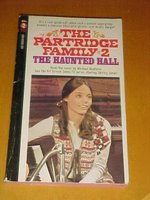
It's Friday. The end of a truly noxious week here in an anonymous cubicle somewhere in the heart of San Francisco. I'm ready for a bit of nonsense...
Don't know why, except the synapses are starting to fray at the edges, but I started to reminisce about books I was quite fond of as a pre-teen. It took a bit to recall the titles, but I did. Here's the list, and what I can recall about each book. Does anybody else remember these? Please, add more to the list!
Maureen Daly, Seventeenth Summer. Man, I read this one many times over, when I was 10, 11...? I swooned over the part where Jack kisses Angie for the first time: End of summer, autumn chill in the air, they went to pick tomatoes or something, and then Jack took Angie's face in his chilled, muddy hands, and...
It was a great scene; the whole book built up to it. I'm glad I was young when I was young. I'm sure that a little old kiss at the end of the summer wouldn't be half so thrilling to 10-year-olds these days.
I also remember something about the older sister Lorraine washing her slips out every night in the sink, the hot mugginess of the summer nights, and a sense of ineffable longing.
Paul Zindel, My Darling, My Hamburger. I remember it was funny. I remember someone named Liz and I think her boyfriend was Sean. I don't recall a hamburger. I think kids still read this book, don't they?
Patricia Dizenzo, Phoebe. I was in the sixth grade (Catholic school, Sister Mary Ann and her cat's-eye glasses) when I checked this book out of the local library. It was about a girl getting pregnant. Very racy for my milieu. Naturally, all the other girls in the sixth grade wanted to borrow it. Naturally, I was eager to loan it out. Well, my best friend Cheryl was reading it during a study period and got caught and snitched on me. Sister Mary Ann, who I suspect was actually Andy Dick in a nun's habit, was shocked and called my mother to let her know I was reading a book that -- here her voice lowered to a whisper -- included the words "missed period" on the book cover flap. When I got home my mom asked to look at the book, read the inside flap and then handed the book back to me, saying in her best semi-bored tone, "Just don't take those kinds of books to school anymore."
The Partridge Family #2: The Haunted Hall. Two things I remember about this book: I read this over and over until some of the pages stuck together when I accidentally spilled chocolate pudding on it. It was supposed to be a gothic, as I recall, and I remember that Laurie Partridge (the book's heroine) referred to Heathcliffe in it, which somehow seemed extremely romantic to me (I was 10, okay!). Can you believe someone is auctioning this book on eBay? Very tempting.
Judy Blume, Are you there God, It’s me Margaret? I remember laughing out loud and being somewhat shocked (and delighted, naturally) over Margaret's precocious conversations with God. Talk to God about periods (missed or otherwise)? What a rebel! (I was going to a school where we weren't supposed to wear shorts under our uniforms because it was deemed unladylike. I asked a priest -- Father Deacon -- no lie -- how the teachers could tell if we wore shorts under our uniform or not. I got kicked out of class. Another time he put his hands over his eyes and said "Ladies, cross your legs. I'm seeing things I shouldn't see." And I said, "Why are you looking?" I got kicked out for that, too.)